Since they’re warm and often undisturbed by humans, attics make great nesting options for many unwanted critters. Most often these pests seek shelter in attics to survive harsh weather during winter or raise young during the spring. The most common animals that live in an attic are raccoons, squirrels, bats, mice, and rats.
Getting rid of an animal in the attic requires more than setting a trap. Different species require specific control strategies to keep you and the animal safe. Long term solutions can involve extensive repairs and remediation. Consider calling an expert the first sign of an animal in the attic.
Need Help with Animal Removal from Attic?
Why is There an Animal in the Attic?
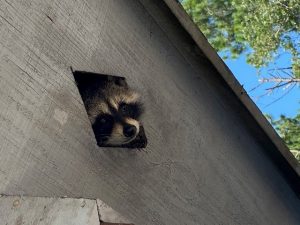
People incorrectly assume cleanliness directly leads to a nuisance animal in the attic. Animals do not discriminate on the type of house, the year it was built, or the size of the structure.
Since all living things need food, water, and shelter to survive, it is not uncommon for a critter to seek shelter on your property. The habitat available to all wildlife is continuously shrinking while the population of wildlife is increasing.
Sometimes animals could could be chased into a home by a predator, and in other cases land development may displace a population which forces them into buildings.
How Do Animals Get Into the Attic?
Nuisance animals are resourceful and will find gaps, crevices, and holes to get into the attic. They do not need large gaps either. A raccoon can get through a hole the size of a grapefruit. Bats need a gap no bigger than a pencil.
When mice, rats, squirrels, or raccoons cannot find a suitable entry point, they can create their own. Rodents can gnaw through a variety of house materials. Raccoons can tear through shingles and plywood.
The Most Common Attic Entry Points:
- Soffits
- Fascia
- Dormers
- Gable Vents
- Roof Ridge Vents
Seven Signs of Animal in Attic
It is rare to actually see an animal in your home. Rats, mice, squirrels, and raccoons go to great lengths to avoid people. The invading animal leaves plenty of evidence in your attic.
When inspecting an attic, we look for the traces an animal leaves behind. Droppings, footprints, and destruction are the most common animal signs we spot.
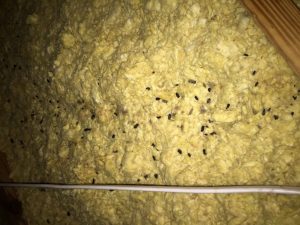
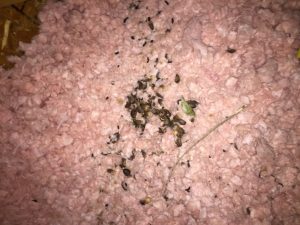
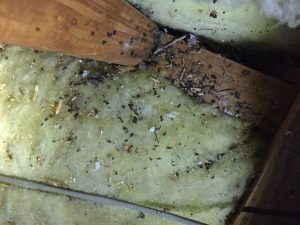
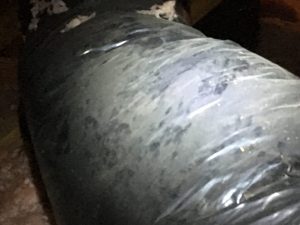
Finding evidence of feces and urine is the clearest sign of a nuisance animal problem. Determining whether they come from animals is crucial, as animal droppings often signal a larger infestation and potential health hazards.
- Raccoons and opossums will have droppings like that of a small dog
- Mice have droppings that are about 1/3-1/5 centimeters in length while rats and squirrels have droppings that are about 1-1.5 centimeters in length. The droppings of squirrels and rats can be very hard to tell apart, which is one reason why hiring a professional may be the best option for you.
- Snakes and birds both excrete in liquid form which contains white urea in it. Their droppings are commonly confused with one another, but a bird’s dropping will contain more urea, therefore, having more white coloration.
- Bat droppings are known as guano. They are mostly found around the entry point(s) that they are utilizing for entry. Guano is small, dark, and shiny. These droppings look like elongated pellets and are normally found grouped together. Please be aware that breathing guano is extremely dangerous.
You may find chewing on pipes or wires in your attic. Many animals will also destroy any personal belongings that you store in your attic.
Another indicator that animals will leave behind is paw prints on your ductwork. Opossums and raccoons have the biggest prints. They each have five fingers, but the palm of a opossum’s print is more triangular.
Raccoon forepaw tracks resemble tiny human handprints with five fingers extending from the palm. Hind paw tracks are similar but show elongated heels that sink deep into the ground.
On the other hand, squirrels and rats have much smaller prints with their front feet having four toes and their hind feet having five.
Squirrels will often collect acorns and leave behind shells in the attic space, which is an easy way to tell when you are dealing with squirrels. Squirrels will also bring nesting material into an attic. Take into account, that you may have more than one animal type in your attic space.
Animals like rats, mice, squirrels, and bats will leave behind rub marks around the openings that they utilize for entry.
The rub marks will be brown to dark brown in color. The more the trails have been utilized, the darker these rub marks will be.
When dealing with mice, rats, and even flying squirrels, you will often see tunneling in the insulation of an attic because insulation makes for a great nesting material. The tunneling will look like small holes that are as big as 3 inches in diameter.
Understandably, finding a snakeskin in an attic indicates you have had a snake in your attic, but there is usually a reason why a snake is there in the first place. A good portion of a snake’s diet consists of rodents and small mammals which suggests the snake may have been or may be in your attic searching for that food source.
Hearing Strange Noises in the Attic
While an animal creates lots of physical evidence, overwhelmingly the most common sign of an animal in the attic is noises and sounds. Whether moving or vocalizations, strange sounds in the attic are a clear sign of a pest.
Identifying the types of noises and when you hear them can provide a significant clue to the species in your attic.
Rats, mice, raccoons, and bats are nocturnal. So if you hear animals in the attic at night, those are the most likely culprits. Squirrels and birds usually are active during the day. If you hear squeaks or scurrying in the morning, it’s probably a squirrel.

- Squirrel Noises in the Attic - Scurrying and scampering during the day are common squirrel sounds.
- Rat and Mice Noises - Squirrels, rats, and mice can all sound similar. Scurrying, scampering, and squeaking could be mice or rats. The biggest difference is when you hear it. Since they are nocturnal, rat and mouse noises happen more often at night.
- Raccoon Noises in the Attic - Loud thumps at night could indicate a raccoon in your attic.
- Baby Raccoon Noises - Crying and whining noises from your attic usually are raccoon kits. We typically only come across a momma raccoon active during the day if she is young, and baby raccoons are very vocal. Keep in mind, that raccoons have one litter per year and give birth in the Spring or early Summer.
- Bat Noises in the Attic - In an enclosed space, you can hear bat colonies make chirps or squeaks. You might also hear the fluttering of bats flying or scratching and rustling noises as they climb and crawl.
- Bird Noises - Fluttering and chirping usually are birds in your attic. Bird noises will be more prevalent during the day while bats are active at night.
- Stinging Insect Noises - Buzzing is a sign of bees, wasps, or yellow jackets. You may possibly have a hive in the attic or in the wall of your house.
Find out what pest might be in your attic!
Five questions to help identify an animal infestation
- How loud is the noise?
- When did the noise occur?
- What kind of sound did you hear?
- What entry points have you seen?
- Have you noticed any animal droppings?
If you hear running at night, it is likely nocturnal animals like rats, mice, or raccoons. When squirrels are in the attic, they are mostly heard during the day.
Brad Woods, District Manager Dallas-Fort Worth
How to Get Rid of Animals in the Attic
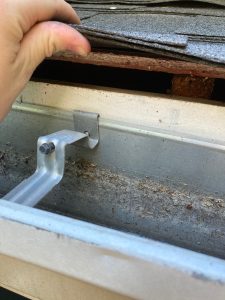
Animals can enter your home through many different locations. The most common areas where we see animals entering are soffits, gable vents, roof returns, pipe stacks, any damaged areas on a property, and even any construction gaps.
In fact, rats can fit through entry points as small as the size of a quarter, and mice can fit into a gap the size of a quarter.
Animals can even enter your home if there is not an entry point present. Because raccoons are so dexterous, they can be very damaging. If they want to use your home as shelter, they will use their hands to create an opening.
Rodents like squirrels, mice, and rats easily gnaw through materials like wood, vinyl siding, shingles, metal, and brick.
How to Prevent Animals from Getting into Your Attic
- Trim any trees that contain branches that touch or are close to your roof or home.
- Keep your yard clear of debris like brush, wood, or rock piles. It creates a livable space.
- Get an inspection from a professional. If you have any potential entry points, we recommend having preventative exclusion to keep all critters out.
Can I DIY Wildlife Removal?
You are certainly welcome to take care of the animal issue on your own. Who wouldn’t want to save money? Before you attempt to trap an animal in your attic, you need to prepare yourself.
First, make sure you have the proper PPE to enter an attic. You must identify the animal to use the appropriate and legal removal techniques. For example, you cannot trap or exterminate bats.
Next, seal all entry points on your home. Do not seal an animal into your attic because this will cause the animal(s) to panic, and in turn, it will cause more destruction.
Finally, you will need to disinfect all contaminated areas of the attic to remove any bacteria associated with the animal’s waste. Alternatively, you can remove and replace your insulation. In addition, please keep in mind that there are different laws in each state when handling different animals.
How Much Does Animal in the Attic Removal Cost?
Preventative care is always the cheapest option, but we completely understand the phrase, “if it ain’t broke, don’t fix it.” That said, call a professional as soon as the problem arises.
The longer an animal issue goes unresolved, the more severe the problem will become. The amount of destruction, feces, and urine in your attic will continue to increase. Animal issues can also become hazardous. For example, rats continue to be the cause of many house fires in the United States each year.
The animal removal process can greatly vary in price depending on the situation as there are many different factors that go into the pricing.
If we need to trap animal(s) in one small attic space and seal 1 entry point, the cost will be much less than a home where we must trap in 3 attic spaces and seal 10 entry points. We provide fair pricing to all our customers, and we want to resolve your issue in the most cost-effective way while providing you with the best service possible.
Attic Restoration after Nuisance Wildlife
After a pest infestation in the attic, attic remediation is a must. This step restores your attic to a safe and clean condition, removing all traces of the nuisance wildlife. Pests like raccoons, squirrels, and rats destroy insulation and contaminate the attic. This introduces health risks to you and your family and lowers the energy efficiency of your house.
These steps from Trutech Wildlife Service restore your attic to a safe and clean condition, removing all traces of the nuisance wildlife.
Clean Up
Pest infestations leave behind contaminated materials that must be carefully removed.
Our cleanup process includes:
- Safely disposing of nesting materials and animal droppings.
- Using specialized sanitation agents, such as industrial-grade disinfectants, to disinfect the area.
- Eliminate harmful bacteria and odors to make your attic a safe environment again.
Insulation Replacement
Your uninvited attic guests may damage insulation during their stay, nesting in it and contaminating it with urine and droppings. During our inspection, we’ll evaluate the insulation and replace it if necessary.
We recommend insulation replacement when:
- Areas are heavily contaminated with rodent waste.
- Insulation has suffered significant water damage.
- Insulation is old and no longer effective.
- There are signs of mold or mildew growth.
TAP Pest Control Insulation
As part of the remediation process, we offer Thermal Acoustical Pest (TAP) Control Insulation. We install TAP insulation to provide long-term protection against future infestations while improving energy efficiency and reducing noise.
This is a specialized insulation that offers multiple advantages over run-of-the-mill insulation, including:
- Pest resistance: TAP insulation is infused with boric acid, which deters insects and other pests.
- Energy efficiency: New insulation helps regulate temperature, adding a layer that reduces heating and cooling costs.
- Noise reduction: TAP insulation offers superior soundproofing compared to traditional insulation, helping keep your home quieter and more comfortable.
Who Should I Call for Animal in Attic Removal?
Due to the dangers of animals in attic removal like entering attics/crawl spaces, climbing ladders, roof work, and chemical handling, we highly recommend you find a company that is licensed and insured. You also want to be sure the company you choose specializes and is knowledgeable in the animal you are dealing with.
A professional will be able to educate you, walk you through the entire animal removal process, answer any questions or concerns you may have, and provide you with additional tips for your home.
Trutech Wildlife Service provides free inspections, and your satisfaction is always guaranteed. Please call us for more information!
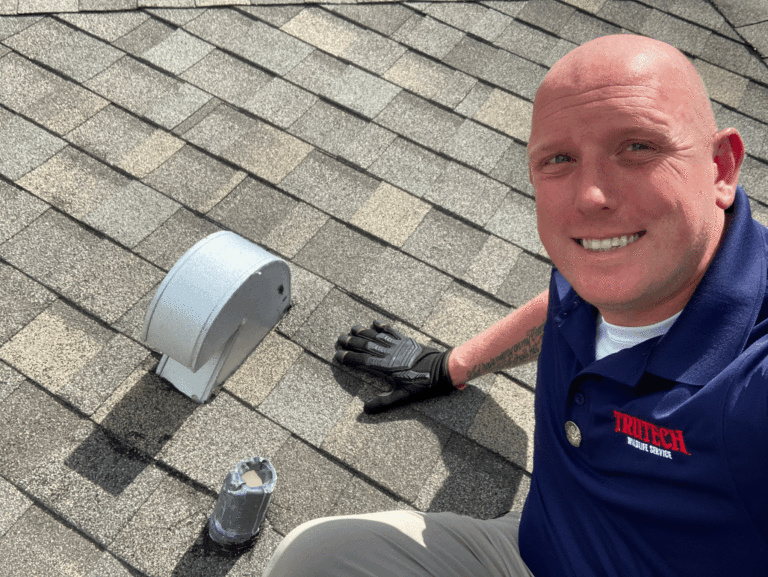
Call Trutech In to Get Wildlife Out




